Sibulan
Sibulan, officially the Municipality of Sibulan (Cebuano: Lungsod sa Sibulan; Tagalog: Bayan ng Sibulan), is a second class municipality in the province of Negros Oriental, Philippines. According to the 2020 census, it has a population of 64,343 people.[3]
Sibulan | |
|---|---|
| Municipality of Sibulan | |
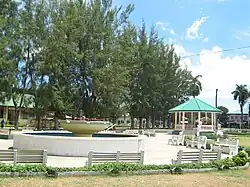 Sibulan Public Plaza | |
 Flag  Seal | |
 Map of Negros Oriental with Sibulan highlighted | |
OpenStreetMap | |
.svg.png.webp) Sibulan Location within the Philippines | |
| Coordinates: 9°21′N 123°17′E | |
| Country | Philippines |
| Region | Central Visayas |
| Province | Negros Oriental |
| District | 2nd district |
| Barangays | 15 (see Barangays) |
| Government | |
| • Type | Sangguniang Bayan |
| • Mayor | Jose A. Abiera (Lakas) |
| • Vice Mayor | Dirkie Y. Fontelo (NPC) |
| • Representative | Manuel T. Sagarbarria |
| • Municipal Council | Members |
| • Electorate | 36,031 voters (2022) |
| Area | |
| • Total | 163.00 km2 (62.93 sq mi) |
| Elevation | 32 m (105 ft) |
| Highest elevation | 285 m (935 ft) |
| Lowest elevation | 0 m (0 ft) |
| Population (2020 census)[3] | |
| • Total | 64,343 |
| • Density | 390/km2 (1,000/sq mi) |
| • Households | 15,785 |
| Economy | |
| • Income class | 2nd municipal income class |
| • Poverty incidence | 10.90 |
| • Revenue | ₱ 252.3 million (2020) |
| • Assets | ₱ 570.7 million (2020) |
| • Expenditure | ₱ 288.6 million (2020) |
| • Liabilities | ₱ 79.8 million (2020) |
| Service provider | |
| • Electricity | Negros Oriental 2 Electric Cooperative (NORECO 2) |
| Time zone | UTC+8 (PST) |
| ZIP code | 6201 |
| PSGC | |
| IDD : area code | +63 (0)35 |
| Native languages | Cebuano Tagalog |
| Website | www |
Sibulan is 5 kilometres (3.1 mi) from Dumaguete. It is the location of Dumaguete Airport, the main airport for Negros Oriental.
Sibulan is also the location of the Balinsasayao Twin Lakes Natural Park, composed of Lake Balinsasayao and Lake Danao. The site, managed by the provincial government, is located 1,047 metres (3,435 ft) above sea level on Mount Talinis.
Geography
Barangays
Sibulan is politically subdivided into 15 barangays. Each barangay consists of puroks and some have sitios.
- Agan-an
- Ajong
- Balugo
- Boloc-boloc
- Calabnugan
- Cangmating
- Enrique Villanueva
- Looc
- Magatas
- Maningcao
- Maslog
- Poblacion
- San Antonio
- Tubigon
- Tubtubon
Sibulan has six coastal barangays: from north to south they are Ajong, Looc, Poblacion, Cangmating, Maslog, Agan-an and Boloc-boloc. The provincial airport, known as the Dumaguete Airport, is actually in Agan-an, Sibulan. There is a growing number of guest houses and beach resorts from Cangmating southward to Dumaguete and the coral reefs of Ajong are attracting more dive boats.
The municipal seat is in barangay Poblacion, approximately midway along the coast of the town. The main municipal port facility is in Poblacion, where a ferry runs every hour to Brgy. Liloan, Santander on the tip of Cebu island. There is also a fishing and freight port in barangay Looc.
Sibulan has two small Marine Protected Areas (MPAs), which are coral reef areas that prohibit fishing, swimming and diving. One is in Agan-an, just north of the airport, the other in Cangmating. These were established to improve the sustainability of the local fishery.
The inland barangays are primarily agricultural and residential with minimal business and public facilities. Most commercial development is along the national highway, which runs the length of the town from Dumaguete in the south to San Jose at the north. Most business and light industry is along the highway in Boloc-Boloc, Maslog, Agan-an and Poblacion including newly opened 100-bed Negros Polymedic Hospital. This is largely urban sprawl from Dumaguete seeking the advantageous tax rates in Sibulan.
Sibulan also boasts a golf course resort, perched on the foothills in barangay San Antonio, just north of the town center.
Climate
| Climate data for Sibulan, Negros Oriental | |||||||||||||
|---|---|---|---|---|---|---|---|---|---|---|---|---|---|
| Month | Jan | Feb | Mar | Apr | May | Jun | Jul | Aug | Sep | Oct | Nov | Dec | Year |
| Average high °C (°F) | 30 (86) |
30 (86) |
31 (88) |
33 (91) |
32 (90) |
31 (88) |
30 (86) |
30 (86) |
30 (86) |
29 (84) |
30 (86) |
30 (86) |
31 (87) |
| Average low °C (°F) | 22 (72) |
22 (72) |
22 (72) |
23 (73) |
24 (75) |
25 (77) |
24 (75) |
24 (75) |
24 (75) |
24 (75) |
23 (73) |
23 (73) |
23 (74) |
| Average precipitation mm (inches) | 26 (1.0) |
22 (0.9) |
28 (1.1) |
41 (1.6) |
95 (3.7) |
136 (5.4) |
147 (5.8) |
126 (5.0) |
132 (5.2) |
150 (5.9) |
98 (3.9) |
46 (1.8) |
1,047 (41.3) |
| Average rainy days | 7.5 | 6.7 | 8.9 | 10.4 | 21.6 | 25.6 | 26.3 | 25.0 | 24.1 | 26.2 | 19.2 | 12.1 | 213.6 |
| Source: Meteoblue[5] | |||||||||||||
Demographics
|
|
| ||||||||||||||||||||||||||||||||||||||||||||||||||||||
| Source: Philippine Statistics Authority[6][7][8][9] | ||||||||||||||||||||||||||||||||||||||||||||||||||||||||
Economy
Education
Colleges:[17]
- Metro Dumaguete College Campus 2 — Magatas
- Negros Maritime College Foundation Inc. — Magatas
- St. Joseph Seminary College — Agan-an
The public schools in the town of Sibulan are administered by two school districts under the Schools Division of Negros Oriental.
Elementary schools:
- Agan-an Elementary School — Agan-an
- Bagtic Elementary School — Sitio Tubod, Enrique Villanueva
- Balugo Elementary School — Balugo
- Bolocboloc Elementary School — Bolocboloc
- Calabnugan Elementary School — Calabnugan
- Cambajao Elementary School — Sitio Cambajao, Balugo
- Cangmating Elementary School — Cangmating
- Cantalawan Elementary School — Sitio Cantalawan, Maningcao
- Escaguit Elementary School — Sitio Escaguit, Enrique Villanueva
- Libertad Ong Calderon Memorial Elementary School — Ajong
- Lo-oc Elementary School — Looc
- Magatas Elementary School — Magatas
- Magsaysay Memorial Elementary School — Campaclan, Poblacion
- Maningcao Elementary School — Maningcao
- Maslog Elementary School — Maslog
- San Antonio Elementary School — San Antonio
- Sibulan Central Elementary School — Yapsutco Street, Poblacion
- Tubigon Elementary School — Tubigon
- Tubtubon Elementary School — Tubtubon
High schools:
- Ajong National High School — Ajong
- Bolocboloc High School — Bolocboloc
- Dr. Benjamin T. Locsin High School — Maslog
- Enrique Villanueva High School — Sitio Tubod, Enrique Villanueva
- Maningcao National High School — Maningcao
- San Antonio National High School — San Antonio
- Sibulan National High School — Osmeña Street, Poblacion
- Sibulan NHS - Balugo Extension — Balugo
- Sibulan Night High School — Diputado Street, Poblacion
- Sibulan Science High School — Campaclan, Poblacion
- Tubigon High School — Tubigon
Gallery
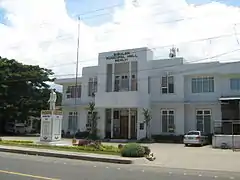 Municipal hall
Municipal hall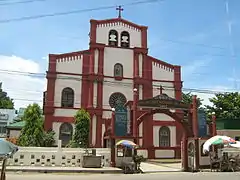 San Antonio de Padua Church
San Antonio de Padua Church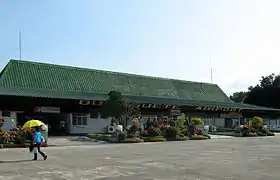
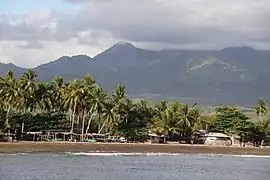 Sibulan shoreline
Sibulan shoreline Lake Balinsasayao
Lake Balinsasayao
References
- Municipality of Sibulan | (DILG)
- "2015 Census of Population, Report No. 3 – Population, Land Area, and Population Density" (PDF). Philippine Statistics Authority. Quezon City, Philippines. August 2016. ISSN 0117-1453. Archived (PDF) from the original on May 25, 2021. Retrieved July 16, 2021.
- Census of Population (2020). "Region VII (Central Visayas)". Total Population by Province, City, Municipality and Barangay. Philippine Statistics Authority. Retrieved 8 July 2021.
- "PSA Releases the 2018 Municipal and City Level Poverty Estimates". Philippine Statistics Authority. 15 December 2021. Retrieved 22 January 2022.
- "Sibulan: Average Temperatures and Rainfall". Meteoblue. Retrieved 6 May 2020.
- Census of Population (2015). "Region VII (Central Visayas)". Total Population by Province, City, Municipality and Barangay. Philippine Statistics Authority. Retrieved 20 June 2016.
- Census of Population and Housing (2010). "Region VII (Central Visayas)" (PDF). Total Population by Province, City, Municipality and Barangay. National Statistics Office. Retrieved 29 June 2016.
- Censuses of Population (1903–2007). "Region VII (Central Visayas)". Table 1. Population Enumerated in Various Censuses by Province/Highly Urbanized City: 1903 to 2007. National Statistics Office.
- "Province of". Municipality Population Data. Local Water Utilities Administration Research Division. Retrieved 17 December 2016.
- "Poverty incidence (PI):". Philippine Statistics Authority. Retrieved December 28, 2020.
- "Estimation of Local Poverty in the Philippines" (PDF). Philippine Statistics Authority. 29 November 2005.
- "2003 City and Municipal Level Poverty Estimates" (PDF). Philippine Statistics Authority. 23 March 2009.
- "City and Municipal Level Poverty Estimates; 2006 and 2009" (PDF). Philippine Statistics Authority. 3 August 2012.
- "2012 Municipal and City Level Poverty Estimates" (PDF). Philippine Statistics Authority. 31 May 2016.
- "Municipal and City Level Small Area Poverty Estimates; 2009, 2012 and 2015". Philippine Statistics Authority. 10 July 2019.
- "PSA Releases the 2018 Municipal and City Level Poverty Estimates". Philippine Statistics Authority. 15 December 2021. Retrieved 22 January 2022.
- "dumaguete.com". Retrieved Sep 30, 2014.
External links
- The travel guide Wikivoyage includes Sibulan in its Dumaguete article.
- Philippine Standard Geographic Code
- Philippine Census Information
- Local Governance Performance Management System